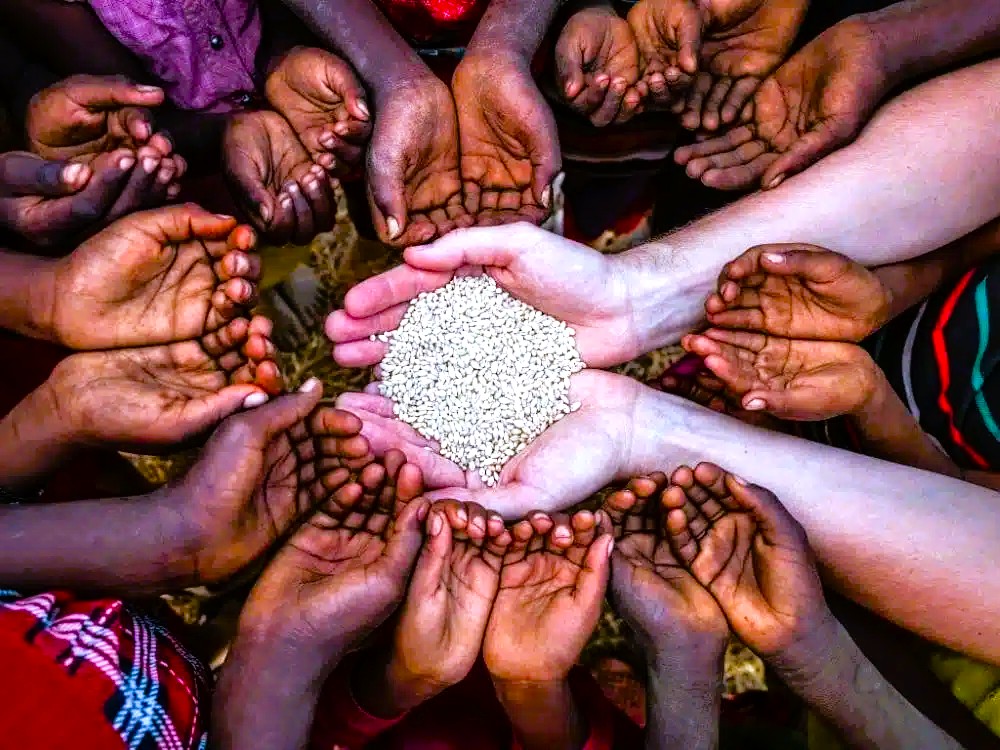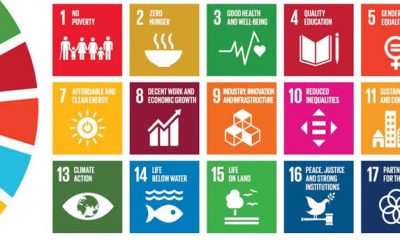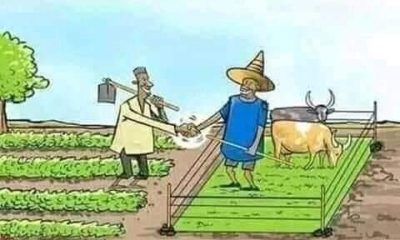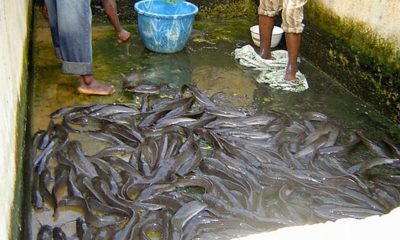Food Security
WHY NIGERIA IS MISSING OUT IN THE LEAGUE OF EMINENT DAIRY PRODUCING COUNTRIES

.(Commemorating World Milk day 1st June )
This would be discussed under four headings.
— DAIRY FARMING IN NIGERIA
—‘ PANACEA FOR INADEQUACIES
—-‘ DAIRY VALUE CHAIN (PROCESSING)
—- COMPARATIVE COST ANALYSIS OF DAIRY/MEAT PRODUCTS
DIARY FARMING IN NIGERIA:
Despite the huge population of cattle herds,’ Sheep and Goats, Nigeria is not in the league of eminent Diary producing countries of the world, this had led to loss in huge amount of Foreign Exchange. It is time to make a paradigm shift from this lackadaisical act and reinforce the unlimited possibilities inherent in us to break the barrier.
Competent Food Technologists should be encouraged to trail blaze the Diary Technological Development.
Using FAO record of 1984-1985 the cattle population in Nigeria was 13 million that was about 36years ago, presently it must have exponentially triple that figure by now.
The popular species are the Bunaji type. Record show that the local Bunaji lactate about 4-6kg milk daily in a cycle of 290 days this is barely enough to feed their calves, leaving nothing for production compared to Holstein Frisian heifers (Europe) producing about 24 – 40kg per day, much still needed to be done to increase the availability of locally produced milk in terms of effort and investment as discussed below if this is done there will be less dependence on imported food items, thereby increasing job opportunity in dairy farming as this will guarantee sales of dairy (milk) to processors and add substantially to non oil related revenue.
● It should be noted that the Cattles here are undernourished and not strong enough the beef are not Processed for export purposes but for domestic consumption.
Various reasons could be adduced to the Low Production
●– The raging Desertification in the Sahel vegetational zone causing drying up of Lake Chad compounded by Insurgency, Banditry, kidnapping and other high end crimes.
● About 90% of cattle in Nigeria are not ranched thereby engaging in Normadic flight across the country resulting in not having enough rest during lactation .
• No steady source of nutrition, Research showed that a certain imported grass from Brazil gives more lactation and help in building up the body .
●Incessant clash between Fulani Herdsmen and local farmers record death of both men and cattle.
● Cattle Rustling: These are armed bandits snatching cows from owners.
●– The
Due to lack of organized Cooperatives society, authentic data on population is rather difficult for policy making use.
Major reason (shortcoming, medium and long term) inhibiting the potential large and small holder dairy farming is lack of Organized Cooperative society which can enable them have opportunity that can enhance their development into modern dairy farming which will see them establishing ranches with adequate feeding of their herds and provision of utilities, services and equipment.
Cooperatives have been the backbone of dairy development in eminent dairy producing countries in Europe, Australia, New Zealand and other countries. Most countries of the world are becoming self sufficient in dairy development this is partly due to their embracing cooperative societies. The banks in Nigeria who could play an important role in the stimulation and expansion of dairy farming by allotting it deserved attention through the provision of financial advice, extending adequate lending facilities (interest rate is two digit 27% this is rather high) where possible are not there. Finance houses ( not Central Bank although NIRSAL Micro Finance bank is now in place. ) should take up risk in SME of Dairy production.
Also the various level of Government where condition is most favourable for dairy farming should take HUMAN CAPITAL DEVELOPMENT issue seriously and be of great assistance by setting aside funds to provide necessary infrastructure to assist dairy farmers providing extension services and encouraging the inclusion of animal husbandry and dairy related courses in institution of higher learning.
Recently, the Federal Government flashed the NIRSAL (Nigeria Incentive Based Risk sharing Agricultural Lending) to provide rail transportation for moving cattle across the country (as of old ) but nothing of such is presently on. NIRSAL should equally embrace Dairy Products by identifying SME in Dairy production not only for beef production. Good policy must be backed with extant law to avoid policy somersault.
■ WHY NIGERIA IS IMPORT DEPENDANT
Absence of commercial dairy farmers coupled with lack of adequate technologies, bureaucracies in Government, lack of will and commitment to forge ahead after initial failures even where we have some farms trying to survive there is no support to actually surmount challenges hence the dairy industry has been depending on importation for our dairy needs.
Apart from raw material, lack of technological knowhow in dairy processing couple with lack of machinery and spare parts for processing plant, hence, expatriates from traditional dairy farming countries of Europe and America are holding sway in the industry. The problem of import dependence has manifested in low capacity utilization in the industry.
As a result of the above, the dairy industry has remained largely under developed.
Large commercial dairy farmers are absent to support the manufacturers. All these inadequate result in
Milk facilities and utensils for milking the animals cow, sheep and goat are not available.
• Absence of electric power for cooling facilities.
• Absence of infrastructure necessary to support production such as Large cold storage facilities at Various Storage location for the highly perishable nature of milk products.
• Lack of refrigerated transportation systems for collection and movement of fresh milk from point to point ,
● Limited network (cold chain) of distribution for product with low shelf life.
PANACEA FOR INADEQUACIES IN MILK INDUSTRY .
Increase of Human Capital Development in both processing technology of milk products and derivatives are essential such as:
■ Yoghurt (set yoghurt, frozen yoghurt, drinking yoghurt), ice cream, pasteurized fresh milk, butter, different types of cheese, sour cream, buttermilk, etc in machinery and equipment technology.
■-Ranching of Animals: The issue of ranching is shrouded in both political intrigue and “Agenda” quagmire, both should be settled by our democratic institutions in which each state should own her ranches for development of our diary industries.
The astronomical rise in the Nations foreign debit (from one regime to the other) should for once activate the Nations manpower technological advancement in Dairy Technology. As this will curb importation of foreign foods.
■ Our higher institution should equally develop curriculum that will produce dairy farmers and technologists.
Cattle should not be seen from the angle of beef only but various dairy products as stated above, dairy production are not enjoying the attention deserved.
For “Pete’s sake” we’ve heard enough of the inadequacies of our electricity supply with the present 7,000 MW of electricity it is grossly inadequate for the population of about 206million.
All we need do is to source for alternative green energy. We must stop waiting till eternity for national grid.
At WUFAS, some of the local dairy derivatives are waiting, all we need is partnership. Let’s kick start with what we have now. We must not be stopped with National electricity supply.
AFAN (All Fermers Association of Nigeria) should be mandated to organize Dairy farmers for accessible Database on population of animals in dairy production. As the national grid increases there will be technological progress and growth. With wide spread penetration of electricity there will be transformation in production methods of many consumer goods dairy inclusive. Increase supply of electricity will open back to life many moribund factories,
■ I would suggest that a policy establishing INDUSTRIAL PACKS powered by Renewable Energy such as local hydro electric power station, solar, wind mill and other green energy be established in various state. This will help to create INDUSTRIAL BELT that will guarantee permanent working class in various cadres. Constant electricity will ensure provision of means for collection, cooling and keeping quality of milk upon arrival at processing facilities.
DAIRY PRODUCTION (VALUE CHAIN)
Pasteurization of milk temperature is 161oF or 71.7oC @ 15secs
Fermented Dairy Products are into 3 classes;
●— Liquid Product which include Acidophilus milk, Butter milk, Kefir and Koumios
●– Semi solid Product: Culture cream and Yoghurt
●– The unripe soft cheese: Bakers cheese, Cottage cheese, cream cheese and quarg.
YOGHURT
Yoghurt taste (flavour) which is formed by Acetaldehyde are divided into 3 main categories
Low content of Acetaldehyde
Medium content of Acetaldehyde
High content of Acetaldehyde
In Yoghurt Production there are 4 types of yoghurt
Set Yoghurt
Drinking Yoghurt
Stirred Yoghurt
Frozen Yoghurt
— SET Yoghurt
Process
Milk standization
Pre heat treatment
Culture/packaging/incubation
Acidification and Acetaldehyde Formation
Cooling at 4oC (Cold chain must be maintained)
The yoghurt is thoroughly mixed and filled directly into retail containers. This is incubated at 43oC for 5 hours. After which is blast cooled to 15oC and later 4oC in chiller note that freezing must be avoided.
Any form of Agitation must be avoided after filled into cups
— DRINKING Yoghurt
Process
Milk standization skim milk in use
Homogenization
Heat treatment
Cooling – 35oC – 43oC
Culture addition and incubation
Structure treatment
Cooling 25oC
Filling
Cold storage
Drinking yoghurt can be categorized as stirred yoghurt with low viscosity, the basic guideline for pre-treatment of the milk and the acidification are same but contrary to stirred yoghurt where certain caution are taken. The coagulum of drinking yoghurt is broken either by centrifugal pump mixers at high speed or by homogenization.
— STIRRED Yoghurt
Process
Milk standization (Fat 0.4%)
Concentration of powder (2-4%)
Homogenization
Heat treatment 90-95oC @ 3-5minute
Cooling (Acidification Temp. 32oC-43oC)
Culture addition (Traditional or mild yoghurt)
Stirring
Cooling 25oC
Filling
Cold storage
For production of stirred yoghurt we suggest you use standardized milk with increase protein content (3.7-3.9%) skim milk or caseinate. The products is normally packed at 20-25oC to obtain an optimal viscosity in final yoghurt too much acidification must be avoided.
Addition of fruit shall be done in the balance tank and packed immediately at maximum time of 1 hour. This is a high viscose consistent
■ FROZEN Yoghurt
Process
Pasteurization of ice mix at 80oC for 2 minutes
Homogenization
Cooling to 5oC
Incubation of mix + yoghurt
Freezing
The taste of the Frozen Yoghurt will very much depend on the ice mix used. Ice Mix consist of
70 % skim milk powder
2.5% milk protein powder
16% sugar
10% glucose
1.5% emulsion/stabilizer
60% water
Natural colour and flavours can be used.
Frozen Yoghurt is a healthier alternative to ordinary ice cream
For Other classes of Diary Products check us out –
COST (VALUE) ANALYSIS OF DAIRY AND MEAT PRODUCTS
Meat/Beef (to be continued…… )
At WUFAS AGR0Net, We are Competent and Reliable Food Processing Technologists into Human Capital Development Consultancy in Food Processing Technology enhancing Global Competitiveness and International Best Practices for the startups, the teeming youthful population, unemployed graduates, propreneurs and other Food handlers through our Entrepreneurial / Empowerment Demonstrative Seminars in FOOD PROCESSING.
Contact us today : 08034064270, 08157784430. Email :wufasagronet @gmail.com. Fb page WUFAS AGRONET.
Food Security
CHARACTERISTICS OF GOOD DETERGENT

CHARACTERISTICS OF GOOD DETERGENT
www.wufasagronet.com
….. @WufasAgronet, we are Food Security (processing) Advocates.
✅Earned FAO, WFP, WORLD BANK, IFAD, IDA, IMF, UNSDGs, USAID, ROCKEFELLER FOUNDATIONS, BBC NEWS, JAGABAN ARMY, PUNCH NEWSPAPERS, GUARDIAN Newspapers, Today Reporters, Ripples News etc TopFan Barges.
✅Member NAAJ, PAAJ, IFAJ AND AFAN.
✅Consultancy Services in Human Capital and Value Chain Development in Food Processing technology.
DETERGENTS used for washing in industries should have the following characteristics.
-Ability to loosen organic matters eg. Soil etc. (organic dissolving power)
-Good rinsing power.
-Adequate wetting power to allow detergent to penetrate the deposit acting quickly and efficiently.
-Good sequestering power – removal of mineral deposits eg. Calcium, magnesium.
-Emulsifying power – fragmenting oil into tiny particles.
-Adequate germicidal power to sterilized dirty detergent solutions.
-Ability to dissolve alkali solutions precipitate of calcium and magnesium salt.
-It should not be corrosive.
-It should posses good buffering and saponifying powers.
The above characters may not be contained in a single detergent but if blended with others rich in some of the characters, a good result may be achieved.
MAJOR SOURCES OF DETERGENTS.
{Alkalis} – Caustic soda is the basic ingredient of detergent however,
there could be addition of other additives to give a property to the detergent. Other basic ingredients are Soda ash, Sodium silicate and others as seen above.
SEQUESTERING AGENT.
This is the action of polyphosphate in precipitation of calcium and magnesium salts in water creating additional wetting agent and polyphosphate to assist sequestration this would constitute most effective and economical clean-in-place detergent for brewing cleanings.
WETTING AGENT.
Known generally as synthetic detergent, Wetting agents are classified into 3 major types :An-ionic and Cat-ionic wetting agents.
The An-ionc type is commonly used for detergent formulation eg. Sulphated alcohols alkyl or aryl sulphonates. Non-ionic are mostly the polyethylonic oxide. On blending of both an ionic and catonic the result may be excessive foaming. It also processes good wetting, dispersing and rinsing power.
STERILISING AGENT.
Alkalis porcess sterilizing power, which increases with pH and temperature.
At WufasAgronet, we are competent and reliable Food Technologists into Human Capital and Value Chain Development Consultancy in Food Processing. Contact us email :wufasagronet@gmail.comPls go through the earlier sent documents.
Food Security
SEASONINGS. FLAVORS. FOOD INGREDIENTS.

✔Contact us @WufasAgronet for wide range of integrated flavors and seasonings, we are Manufacturers’ Representative.
…. @WufasAgronet we are Food Security (Processing) Advocates.
✅Earned FAO, WFP, WORLD BANK Group, UNSDGS, ROCKEFELLER FOUNDATIONS, BBC NEWS, JAGABAN ARMY, PUNCH NEWSPAPERS, GUARDIAN Newspapers, Today Reporters, Ripples News, etc TopFan Barges.
✅Member NAAJ, PAAJ, IFAJ & AFAN.
✅CONSULTANCY SERVICES IN HUMAN CAPITAL AND VALUE CHAIN DEVELOPMENT IN FOOD PROCESSING.
✔FLAVORS
BAKERY & PASTRY FLAVORS
*Vanilla flavor
*Condensed milk flavor
*Butter scotch flavor
*Enzyme chocolate flavor
*Enzyme butter flour
*Milk flavor
*Coconut flavor
✔ CONFECTIONERY & CANDY FLAVORS
*Strawberry flavor
*Chocolate flavor
*Orange flavor
*Butter vanilla flavor
*Banana flavor
*Mango flavor
*Lemon flavor
*Milk flavor
*Vanilla flavor
*Apple flavor
*Mixed berry flavor
*Coconut flavor
*Caramel flavor
*Honeydew flavor
*Condensed milk flavor
*Peanut flavor
*Cheese flavor
✔BEVERAGE FLAVORS
*Apple flavor
*Coconut flavor
*Caramel flavor
*Mango flavor
*Lemon flavor
*Banana flavor
*Pineapple Flavor
*Orange flavor *Strawberry flavor
*Natural Ginger flavor
*Malta flavor
*Grape flavor
*Raspberry flavor
✔ENCAPSULATED FLAVORS
*Strawberry flavor
*Raspberry flavor
*Mixed Berry flavor
*Orange flavor
*Apple flavor
*Banana flavor
✔BEVERAGES (CONCENTRATES, COMPOUNDS, BASES AND EMULSIONS) :
*Pineapple
*Lemon
*Ginger
*Cola
*Black currant
*Orange
*Strawberry
*Chapman
*Apple
*Banana
*Mixed fruit
*Cocopina
✔SAVOURY FLAVORS
*Beef flavor
*Chicken flavor
*Tomato flavor
*Cheese flavor
*Seafood flavor
*BBQ flavor
*Roasted flavor
*Smoked fish flavor
*Suya flavor
*Peanut flavor
*Roasted Chicken flavor
*Sardine flavor
*Smoke flavor
✔MILK POWDER :
*Fat filled milk powder
*Skimmed milk powder
*Full cream powder
*Flavored milk powder
*Butter milk powder
✔ICE-CREAM, YOGHURT & DAIRY FLAVORS :
*Yogurt flavor
*Vanilla flavor
*Strawberry flavor
*Banana flavor
*Mixed Berry flavor
*Chocolate flavor
*Cherry flavor
*Mango flavor
✔SEASONINGS:
FOOD SEASONINGS
*Beef seasoning
*Chicken seasoning
*Tomato seasoning
*Cheese seasoning
*BBQ Seasoning
*Seafood seasoning
*Noddles seasoning
*Pasta seasoning
*Jollof seasoning
✔SPICES :
*Cinnamon powder
*Onion powder
*Ginger powder
*Garlic powder
*Paprika powder
*Nutmeg powder
✔FOOD INGREDIENTS :
*Fat Replacer (Handisol – 25)
*Sweetener
✅OTHERS :
*Real meat reaction pastes
*Vegemeat for sausage roll
*Spice flavor oil
*Liquid and oil soluble flavor
*Soup and gravy mixes
*Ice cream premix
*BBQ sauce
*Tomato /Pizza sauce etc.
At WufasAgronet , we are competent and reliable Food Technologists into Human Capital and Value Chain Development Consultancy in Food Processing technology training the teeming youthful population including teirary institutions graduates in Global Competitiveness and International Best practices in Food Processing technology.
Contact email wufasagronet@gmail.com
Food Security
SECURITY PATHWAYS IN RELATION TO SUSTAINABLE FOOD SECURITY OF A NATION.

Good governance is predicated on ensuring the actualisation of the various security architecture of a Nation. The political barometer is also monitored through the efficiency of the security pathways which are :
INTERNAL SECURITY, INFORMATION/COMMUNICATION. , FOOD SECURITY, HEALTH ,EDUCATION, ELECTRICITY, TRANSPORTATION AND INDUSTRIAL GROWTH.
.
All the above are the essential security systems that can produce and provide QUALITY POPULATION through good and quality SUPERVISION
✅NATIONAL Security of life and properties is the (numero uno) number one responsibility of the Head of government be it President, Head of state and others. The mandate to secure life and property is paramount , they control and command the apparatus of security such as adequate Policing, effective Armed forces- Army for protection against external or internal aggression. Customs / Immigration for vigilant boarders patrol to prevent smuggling and immigration control amongst many others . Equipping them with weapons, Aircrafts, Vehicles, Boats etc.
For effective surveillance. In tackling the menace of bandits and kidnappers who have taken over the forest prohibiting farming activities . Armed Forest Guards / Rangers should be introduced.
INFORMATION/COMMUNICATION.
The entire world is in information age.
The constitution clearly stipulate that every person shall be entitled to freedom of expression, freedom to hold opinions and to receive as well as to impact ideas and information.
However, it is the opinion of this writer that freedom be guided with secured intent to prevent abuse that may result in conflicts and war through hateful and unguided utterances.
The most acceptable form of communication is such that promote humane, responsible and patriotic reportage upholding the concept of discipline and promoting values nationally and internationally.
A lot of opportunity mostly untapped abound for investment in Information and communication like Print, Electronic and ICT media.
For industrial growth, information through advertisement, publication and social media is vital for public awareness.
FOOD SECURITY
Whether one eat to live or live to eat is a matter of semantics the bottom – line is Food is the main sustainace of bodies and souls. The importance of food cannot be over emphasised . knowing this fact of life has made the developed world to appropriately plan for provision of quality food for their citizens. Provision of food is prioritize in their national agenda. It is on this note that the United Nation’s clarion call to others in the world to emulate the culture of Sustainable Food Security ensuring the Tripple A(s). of AVAILABILITY, ACCEPTABLITY and AFFORDABILITY. ( UN 2030 food security agenda) of good quality food for the underdeveloped countries who are import dependent on basic food items such as Rice, Sugar, Dairy , Beverages etc .
Presently, Nigeria is revolutionising agrioprenuerial activities, it’s hoped that the present policies on agriculture will not be Summersaulted. The Maputo declaration on allocation of minimum 10% of the country’s annual budget must go to agriculture. Food must be made a constitutional right for all. The authority must take time to support Micro and Small scale Agroprenuerails activities to adapt to climate change. Agroprenuerail activities is the surest way to lift hundreds of millions out of hunger, poverty, conflict and deaspiration.
HEALTH CARE
Health is wealth – Primary Health care delivery must be taken to the grassroot levels, while Rural Health care moblisation be made available and effective all must be well equipped with vaccines, drugs, consumables and other biologicals.
— Ensure maintenance of standard by private sector through effective monitoring.
— Tapping into Herbs Processing , local medical herbs be Researched into by National Institute of Pharmaceutical RnD. In Collaboration with Fed Mins. of Science and Technology.
— Integration of alternative medicine into health care.
— Health insurance scheme must be intensified on .
— Stemming of illegal importation of smuggled fake drugs and illegal drug manufacturing in the country.
EDUCATION
A Society, Community and Nation is as good as the percentage of her literary population. The various levels of education are Primary , Secondary and teriary education 6-3-3-4 .Education must attract appropriate budget at all time. Education is being administered by Public and Private participation at all levels. The special education must receive attention by provision of special equipment such as braille machine, audiometer etc.
ELECTRICITY
To the chagrin of the unsuspecting consumers and Contrary to claim of the generation companies that generation capacity has improved to 7000 MW , the actual has been fluctuating between 2500 -3500 MW.(April 2019)
The idea of mono grid must be jettison while the legislation be relaxed to accommodate Private participations in generation. While effort must be intensified on the Green Bond of #10.97bn raise in December 2018. for financing of SOLAR energy.
Industrial development is unachievable without steady supply of electricity. A green belt of
Industrial Parks on Green energy is recommended in all the States of federation.this will sustain industrial activities that will promote growth.
TRANSPORTATION
This sector is an indispensable catalyst for stimulating economic, social, political and strategic/defence development of a Nation. All the National Development plans must accord the transport sector very high priority. In the formulation of National Transport policy, there must be defined objectives such as economic efficiency and coordinated development plan.
All forms of transportation system are embraced in Nigeria. Motor ,Railway transportation, inland waterways, aviation terminal and handling facilities seaports, airports and riverports including other ancillary facilities.
The administration of Transportation is vested in both Fed. Ministry of Works and Housing (Fed. Highways – Interstate roads Construction and maintenance) and State Ministry of Works/Transport (interstate roads while LG is responsible for Urban and Rural roads Construction and maintenance.
Aviation Ministry for Civil Aviation, Airports Development Management and Metrological services.
Internationally, the railway system is more affordable and relatively saver the frequency in Nigeria must be upgraded not scanty show up as is now the case.
INDUSTRIAL GROWTH
The economic growth rate ( 2019) is 2.1% ,this development is not unconnected with the dismal performances of the various indices above. eg the manufacturing growth rate is presently less than 7% although the Fedreral government set a 10.6% goal in 2017.which was to be driven by SME. Productivity is the only stimulant for Industrial growth. Farming output is barely about 22% mostly subsistence. .about 55% of work force is absorbed by agriculture. The major farming communities in North East, Middle belt downwards to the southern section are being sacked either Boko Haram terrorist or Pasteuralist /Farmers conflicts and banditry.
The various activities as enumerated in this writeup are all depended on Food security system. FOOD SECURITY MUST BE IN THE FRONT BURNER TO ACHIEVE SUCCESS. IN OTHER SEGMENTS.
CONCLUSION
— FOOD Security issues must be in the front burner of government’s agenda. Since it encompasses all other activities.
— The effectiveness of other parasatal must be ensured through adequate supervision.
— TO PREVENT IMMINENT DANGER OF FAMINE. Forest Guards (armed) must be appropriately deployed to secure the large expanse of the forest for Farming activities.
— Indigenous Reserch and Development on local Technology be improved on.
— Electricity generation from Green Energy source should be encouraged in the Industrial parks.
— Food Security system must be made a CONSTITUTIONAL RIGHT for all the citizenry.
At WUFAS AGR0Net, we are Competent and Reliable Food Processing Technologists ,into Human Capital Development Consultancy. Centering on ETHICS of Food Processing Technology. Training on industrial food processing (General Manufacturing Principles ) to the teeming youthful population, startups and other Food handlers. We are seeking Collaboration and Strategic partnership with corporate bodies, NGOs and others
Interested in Food Security.
Contact: 08157784430, 08034064270.
Emails wufasagronet @gmail.com
-

 Environmental3 years ago
Environmental3 years agoOPINION: AN ACCESSMENT OF NIGERIA’S PERFORMANCE IN THE OPTICS OF THE UN 17 SUSTAINABLE DEVELOPMENT GOALS AGENDA 2030. ( Periodic quaterly review & update — ( September ’22)
-

 Food Security3 years ago
Food Security3 years agoREALITIES OF LARGE SCALE INTEGRATED AGROPRENUERAIL FARMING AND FOOD PROCESSING BUSINESS IN NIGERIA. (Update)
-

 Food Security4 years ago
Food Security4 years agoEXCITING FACTS ABOUT RANCHING
-

 Food Security3 years ago
Food Security3 years agoTOP SEVEN AGRICULTURAL COMMODITIES WITH HUGE UNTAPPED POTENTIALs – update
-

 Food Security4 years ago
Food Security4 years agoMITIGATING THE MENACE OF CLIMATE CHANGE THROUGH GREENBOND ISSUANCE.
-

 Food Security3 years ago
Food Security3 years agoFISH PROCESSING TECHNOLOGY
-

 Food Security4 years ago
Food Security4 years agoTHE ROLE OF E -COMMERCE IN SYNERGISING AGRICULTURAL VALUE CHAIN DEVELOPMENT IN AFCTA IS SINE QUA-NON.
-

 Food Security3 years ago
Food Security3 years agoTHE IMPENDING GLOBAL FAMINE FROM THE PERSPECTIVES OF THE WORLD INSTITUTIONAL LEADERS.




